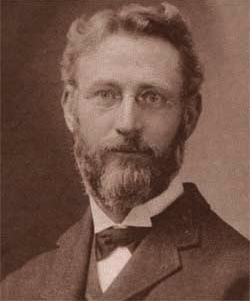Lesson 6: The Covenantal Horizon
What Is the Covenantal Horizon?

Have you ever climbed a mountain or hiked up a steep hill, and stood breathless at the summit, enjoying the reward of a spectacular view? There’s nothing like seeing plains and forests and hills stretching out to the horizon where earth and sky blend together, or where sharp-pointed mountains thrust up into the clouds.

Just like the horizon in the picture above, the Covenantal Horizon is majestic, heart-stirring, and worship-producing.
And the Covenantal Horizon is all about biblical theology, the first of the four disciplines I introduced in the previous step. There I briefly explained what biblical theology aims to do, but we need to define it more fully before we study how to integrate it with the study of a passage, using extrabiblical literature.
A Definition of the Covenantal Horizon
Theologian Jim Hamilton writes that “[t]o do biblical theology is to think about the whole story of the Bible.”¹ Even though that story is told in 66 books, Jason DeRouchie emphasizes that every book in the Book “fits together and points to Christ.”² Michael Lawrence explains that the Bible is ultimately “a single book with a single plot—God’s glory displayed through Jesus Christ.”³ And Andy Naselli defines biblical theology this way: "Biblical theology studies how the whole Bible progresses, integrates, and climaxes in Christ."⁴
When we put these helpful descriptions together, we can see that to do biblical theology is to read and study the Bible as God’s book for us about Christ. So to study the Covenantal Horizon in relation to a specific passage is to aim “to understand [it] in relation to the whole” storyline of Scripture, to see where it takes place in the Bible’s story that culminates in Christ.⁵
Sigurd Grindhiem uses the illustration of bricks used to build a house:
We may liken the many books of the Bible to the different building blocks that are used to build a house. Each of these building blocks may have a fascinating history of their own. Some of them may even contain materials that originally were used for completely different purposes. But when the house is built, each of the blocks becomes a part of the building. So also with the books of the Bible. Each book has its own history, but in the end they all become a part of the final product, the Bible.
—Sigurd Grindheim, Introducing Biblical Theology, 2.


Now let’s summarize all this into a memorable definition:
The definition of the Covenantal Horizon: The horizon that interprets each unit of Scripture as part of God’s unfolding plan of redemption in Christ⁶
The Goal of the Covenantal Horizon
Of course, the overall goal of the Covenantal Horizon is the same as in every area of life: to bring glory to God in Christ! Geerhardus Vos, who cemented biblical theology as a vital discipline for evangelical theologians in the late 19th century, wrote this:
Let us not forget... that as of all theology, so of Biblical Theology, the highest aim cannot lie in man, or in anything that serves the creature. Its most excellent practical use is surely this, that it grants us a new vision of the glory of Him who has made all things to the praise of His own wonderful name.
—Geerhardus Vos, “The Idea of Biblical Theology as a Science and as a Theological Discipline,” in Inauguration of the
Rev. Geerhardus Vos, Ph.D., D.D., as Professor of Biblical Theology, 40.

So how does the Covenantal Horizon do that in particular?
Matthew Emerson contends that “biblical theology helps us to see the ‘big picture’ of Scripture and how a particular passage fits into that.”⁷ And remember, that “big picture” is the story of the Bible.
Many have tried to summarize that big picture. Thomas Schreiner believes “that there are a number of different ways to put together the story line and theology of the Scriptures that are legitimate,” and that therefore “[w]e should not insist... that one theme captures the whole.”⁸ Nevertheless, here are some attempts:

The kingdom of God
—Thomas R. Schreiner, The King in His Beauty: A Biblical Theology of the Old and New Testaments, xii–xiii.

God’s kingdom through God’s covenants
—The title of Gentry and Wellum’s concise book on biblical theology

And that biblical story finds its apex, its mountain-peak of glory, in the person and work of Jesus Christ. You can see this in each of the three summarizing themes above:
He is the one who experienced God’s judgment so that he could bring us salvation, thus glorifying God.
He is the one who established God’s kingdom through his death and resurrection and ascension, and who reigns now as God’s King.
He is the one whose person and work is the focus of the covenants, the backbone of Scripture. And the New Covenant he inaugurated is the high point of the covenants, their end and goal.
And when we understand who Jesus is and what he has done, through the Old Testament and into the New, our souls are thrilled with a clear view of God’s glory, seen as it is “in the face of Jesus Christ” (2 Cor 4:6).
Therefore, this must be our goal:
The goal of the Covenantal Horizon: To correctly place a passage of Scripture within the biblical story, so we can see and savor how it points to Jesus⁹
Choose one of the three themes above and explain how it finds its apex in Jesus’ person and work.
Log in / create an account to enroll or continue where you left off.
In the next step, we’ll spend a little time meditating on the beauty of Christ as the center of Scripture.
The Biggest Story
Pastor and author Kevin DeYoung wrote and narrated a beautiful description of the Bible’s story, called “The Biggest Story.” You can watch the first chapter below, and purchase the whole video for download here.